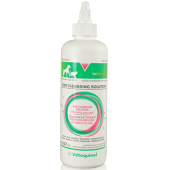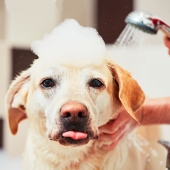Not every square inch of your dog’s body is covered in thick, fluffy fur. Areas like the nose, earflaps, belly and footpads are made of sensitive skin not unlike our own. Some dog breeds have naturally short or thin hair. And just like humans, dogs who remain unprotected under the sun for too long can get sunburned. Here’s what you need to know to avoid sunburn for your dog.
Why skin care is important
Beneath the fur, dog skin is composed the same way as human skin: a subcutaneous layer of muscle and fat, a dermis layer where blood vessels and hair follicles are located, and the epidermis outer layer. Without adequate protection, the sun’s harmful UVA rays can damage a dog’s skin deeply, the same way it affects humans. The result: the skin becomes swollen, red, dry or cracked, warm and sensitive to touch or outright painful.
In pets as in humans, too much sun exposure can cause severe health issues, including skin infections and cancer.
Some dog breeds are more vulnerable to sunburn
White-haired, pink-skinned and thin-haired dogs are more easily affected by sunburn than animals with darker and thicker fur. This makes certain dog breeds like Boxers, Terriers, Dalmatians and Greyhounds more vulnerable overall.
Protect your dog from summer heat
The best way to protect your dog from sunburns is to keep them indoors when the sun is at its peak, from late morning to midafternoon. Schedule your daily walks early in the day or in the evening, when the temperature is lower and the sidewalks and pavement are cooler. If you allow your dog outside during the hottest part of the day, make sure they have access to water and shade, such as a doghouse, a covered porch or underneath a tree.
Your dog needs sunscreen too
If you expect your dog will be exposed to the sun for several hours (or during peak time), a sunscreen specifically designed for canine use is the safest protection. If no dog sunscreen is available, it’s generally safe to use a broad-spectrum sunscreen formulated for kids and babies by taking some additional precautions. Make sure the product is fragrance-free, and that the ingredients don’t include zinc oxide (which is toxic to dogs).
Apply sunscreen to your dog’s sensitive areas: nose, earflaps, belly and any shaved or bare patches. Be careful not to get any in your dog’s eyes, and after application, watch your dog for a few minutes, making sure they don’t lick the sunscreen before it sets.
Sunburn treatment for dogs
As soon as you notice visible signs of sunburn, immediately take your dog inside or in the shade. You may apply cool compresses to soothe the skin and monitor symptoms. If the sunburn seems severe, contact your veterinary clinic for advice; a physical exam followed by a daily treatment may be required to prevent infection and further complications.






